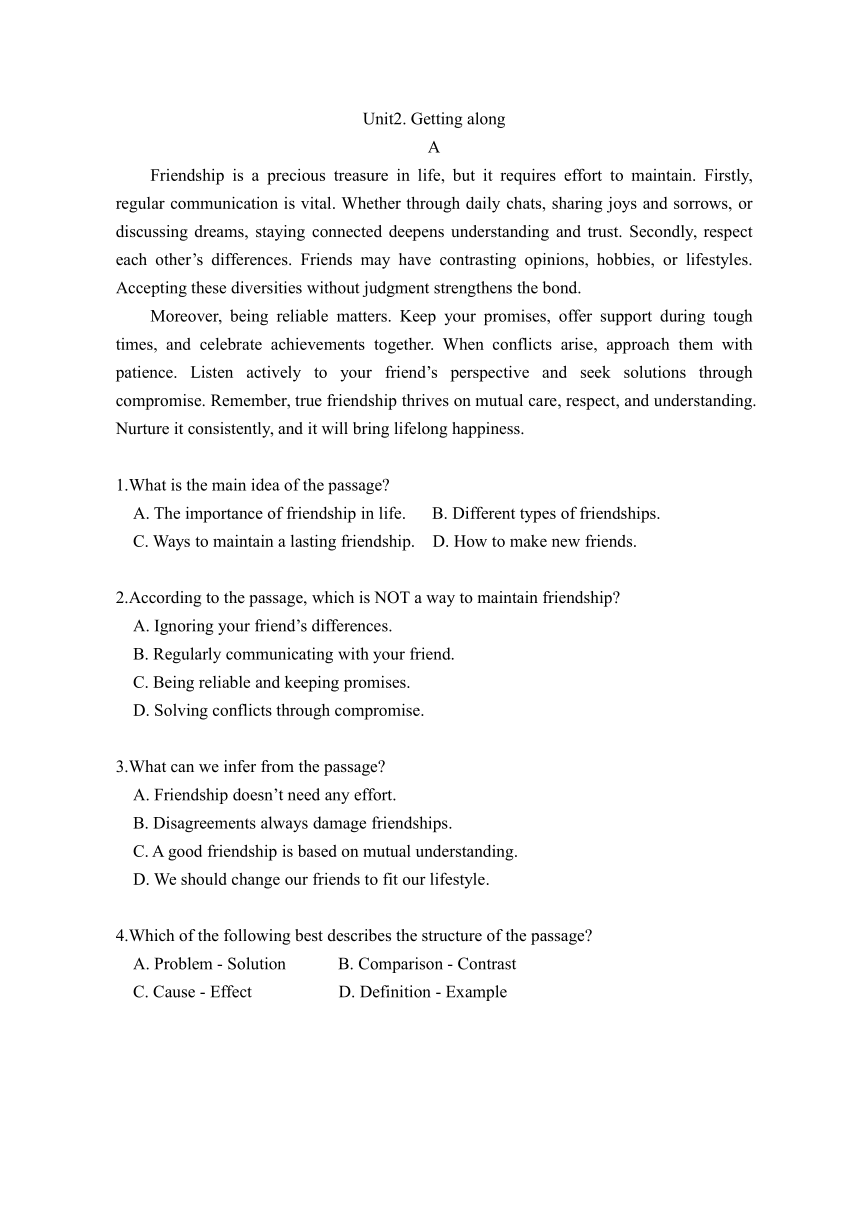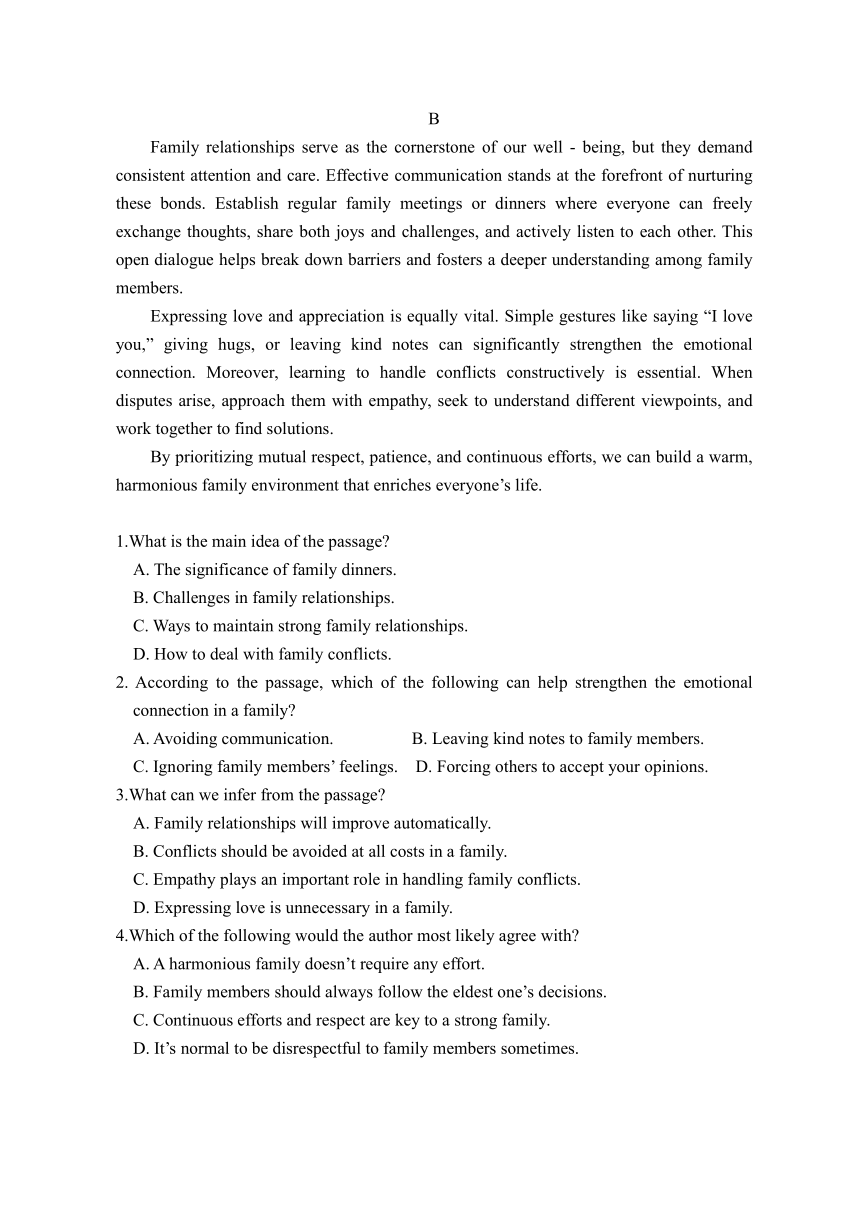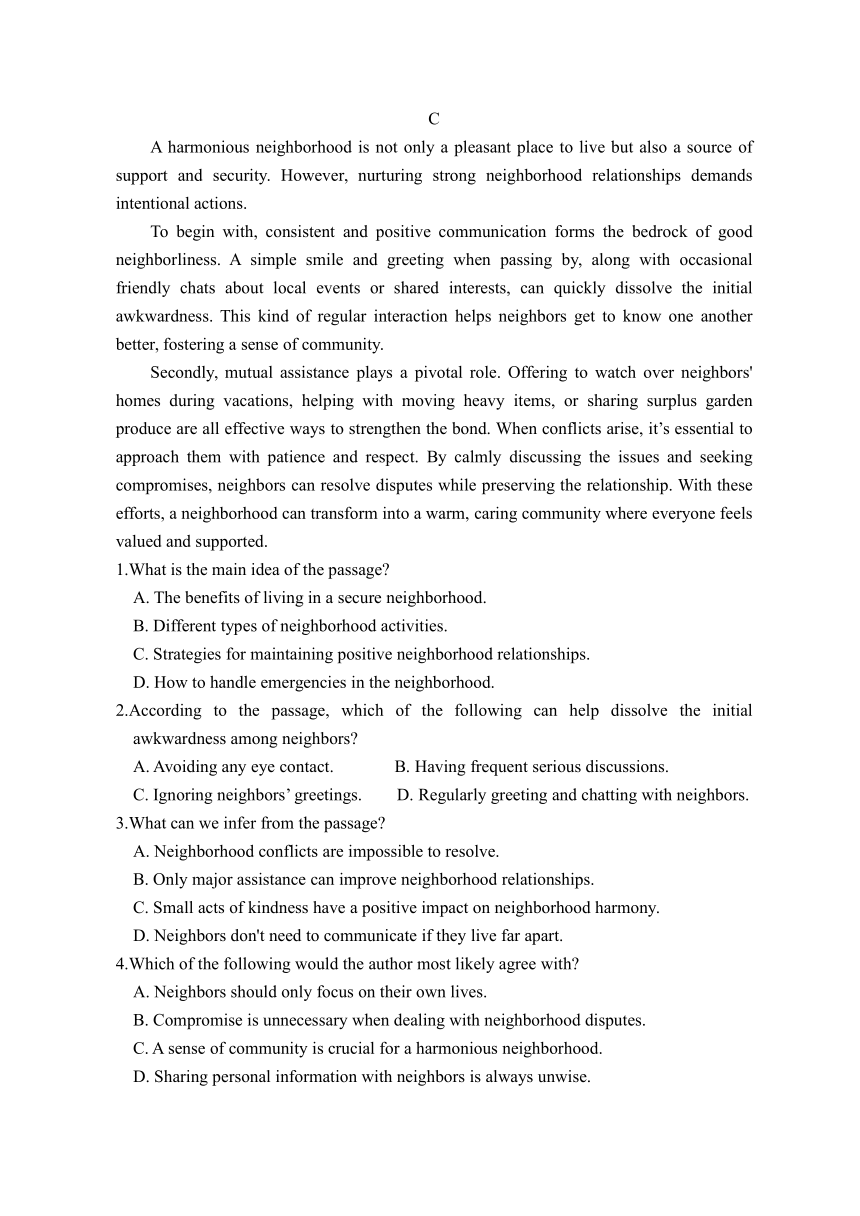2025外研版八上英语专项练习之阅读理解Unit2.Getting along(含答案解析)
文档属性
| 名称 | 2025外研版八上英语专项练习之阅读理解Unit2.Getting along(含答案解析) |  | |
| 格式 | |||
| 文件大小 | 172.7KB | ||
| 资源类型 | 试卷 | ||
| 版本资源 | 外研版 | ||
| 科目 | 英语 | ||
| 更新时间 | 2025-06-26 18:00:38 | ||
图片预览



文档简介
Unit2. Getting along
A
Friendship is a precious treasure in life, but it requires effort to maintain. Firstly,
regular communication is vital. Whether through daily chats, sharing joys and sorrows, or
discussing dreams, staying connected deepens understanding and trust. Secondly, respect
each other’s differences. Friends may have contrasting opinions, hobbies, or lifestyles.
Accepting these diversities without judgment strengthens the bond.
Moreover, being reliable matters. Keep your promises, offer support during tough
times, and celebrate achievements together. When conflicts arise, approach them with
patience. Listen actively to your friend’s perspective and seek solutions through
compromise. Remember, true friendship thrives on mutual care, respect, and understanding.
Nurture it consistently, and it will bring lifelong happiness.
1.What is the main idea of the passage
A. The importance of friendship in life. B. Different types of friendships.
C. Ways to maintain a lasting friendship. D. How to make new friends.
2.According to the passage, which is NOT a way to maintain friendship
A. Ignoring your friend’s differences.
B. Regularly communicating with your friend.
C. Being reliable and keeping promises.
D. Solving conflicts through compromise.
3.What can we infer from the passage
A. Friendship doesn’t need any effort.
B. Disagreements always damage friendships.
C. A good friendship is based on mutual understanding.
D. We should change our friends to fit our lifestyle.
4.Which of the following best describes the structure of the passage
A. Problem - Solution B. Comparison - Contrast
C. Cause - Effect D. Definition - Example
B
Family relationships serve as the cornerstone of our well - being, but they demand
consistent attention and care. Effective communication stands at the forefront of nurturing
these bonds. Establish regular family meetings or dinners where everyone can freely
exchange thoughts, share both joys and challenges, and actively listen to each other. This
open dialogue helps break down barriers and fosters a deeper understanding among family
members.
Expressing love and appreciation is equally vital. Simple gestures like saying “I love
you,” giving hugs, or leaving kind notes can significantly strengthen the emotional
connection. Moreover, learning to handle conflicts constructively is essential. When
disputes arise, approach them with empathy, seek to understand different viewpoints, and
work together to find solutions.
By prioritizing mutual respect, patience, and continuous efforts, we can build a warm,
harmonious family environment that enriches everyone’s life.
1.What is the main idea of the passage
A. The significance of family dinners.
B. Challenges in family relationships.
C. Ways to maintain strong family relationships.
D. How to deal with family conflicts.
2. According to the passage, which of the following can help strengthen the emotional
connection in a family
A. Avoiding communication. B. Leaving kind notes to family members.
C. Ignoring family members’ feelings. D. Forcing others to accept your opinions.
3.What can we infer from the passage
A. Family relationships will improve automatically.
B. Conflicts should be avoided at all costs in a family.
C. Empathy plays an important role in handling family conflicts.
D. Expressing love is unnecessary in a family.
4.Which of the following would the author most likely agree with
A. A harmonious family doesn’t require any effort.
B. Family members should always follow the eldest one’s decisions.
C. Continuous efforts and respect are key to a strong family.
D. It’s normal to be disrespectful to family members sometimes.
C
A harmonious neighborhood is not only a pleasant place to live but also a source of
support and security. However, nurturing strong neighborhood relationships demands
intentional actions.
To begin with, consistent and positive communication forms the bedrock of good
neighborliness. A simple smile and greeting when passing by, along with occasional
friendly chats about local events or shared interests, can quickly dissolve the initial
awkwardness. This kind of regular interaction helps neighbors get to know one another
better, fostering a sense of community.
Secondly, mutual assistance plays a pivotal role. Offering to watch over neighbors'
homes during vacations, helping with moving heavy items, or sharing surplus garden
produce are all effective ways to strengthen the bond. When conflicts arise, it’s essential to
approach them with patience and respect. By calmly discussing the issues and seeking
compromises, neighbors can resolve disputes while preserving the relationship. With these
efforts, a neighborhood can transform into a warm, caring community where everyone feels
valued and supported.
1.What is the main idea of the passage
A. The benefits of living in a secure neighborhood.
B. Different types of neighborhood activities.
C. Strategies for maintaining positive neighborhood relationships.
D. How to handle emergencies in the neighborhood.
2.According to the passage, which of the following can help dissolve the initial
awkwardness among neighbors
A. Avoiding any eye contact. B. Having frequent serious discussions.
C. Ignoring neighbors’ greetings. D. Regularly greeting and chatting with neighbors.
3.What can we infer from the passage
A. Neighborhood conflicts are impossible to resolve.
B. Only major assistance can improve neighborhood relationships.
C. Small acts of kindness have a positive impact on neighborhood harmony.
D. Neighbors don't need to communicate if they live far apart.
4.Which of the following would the author most likely agree with
A. Neighbors should only focus on their own lives.
B. Compromise is unnecessary when dealing with neighborhood disputes.
C. A sense of community is crucial for a harmonious neighborhood.
D. Sharing personal information with neighbors is always unwise.
D
A healthy teacher - student relationship is crucial for effective learning and a pleasant
school experience. To build and maintain such a relationship, both teachers and students
need to make efforts.
First, mutual respect serves as the foundation. Students should respect teachers’
knowledge, experience, and authority, showing politeness in daily interactions. Teachers, in
return, should respect students’ individuality, opinions, and learning pace. Regular and
open communication is also essential. Students can actively ask questions, share their
difficulties in study or life, and teachers should respond promptly and patiently, providing
guidance and support.
Moreover, understanding each other’s perspectives helps strengthen the bond.
Teachers can try to understand students’ stress and challenges, while students should
consider teachers’ responsibilities and expectations. With these approaches, a positive,
supportive teacher - student relationship can be established, which benefits everyone
involved in the educational process.
1.What are two ways students can respect teachers according to the passage
2.Why is open communication important for teacher - student relationships
3.How can teachers and students better understand each other
答案与详解
A 篇
1.C. 解析:文章开篇指出友谊需要努力维系,随后从“定期沟通”“尊重差异”“可
靠”“耐心解决冲突”等方面具体阐述维护友谊的方法,核心围绕“如何维系长久的
友谊”展开,而非友谊的重要性、类型或交友方式。
2. A. 解析:文章明确提到“respect each other’s differences”(尊重彼此的差异),
并强调“accepting these diversities”(接受多样性),而“忽略朋友的差异”与原文
表述相悖。B、C、D 选项均对应文中提到的维系方法(定期沟通、保持可靠、通过
妥协解决冲突)。
3. C. 解析:文中提到“true friendship thrives on mutual care, respect, and understanding”
(真正的友谊建立在相互关心、尊重和理解之上),可推断 C正确。A 选项与首句
“friendship requires effort”矛盾;B选项“disagreements always damage friendships”
过于绝对,文中提到冲突可通过耐心和妥协解决,并非必然破坏友谊;D选项“改变
朋友以适应自己的生活方式”与“accepting diversities”相悖。
4. A. 解析:文章开篇指出“友谊需要努力维系”(隐含“维系友谊是需要解决的问
题”),随后通过多个段落提出具体的解决方法(定期沟通、尊重差异等),属于“问
题-解决方案”结构。其他选项中,“对比”“因果”“定义-举例”均不符合文章逻
辑。
B 篇
1. 答案:C. 解析:文章开头指出家庭关系需要持续关注和维护,随后从“有效沟通”
“表达爱与感激”“建设性处理冲突”等方面具体说明维系亲密家庭关系的方法,核
心围绕“如何维护牢固的家庭关系”,而非单一的家庭晚餐意义、冲突挑战或处理冲
突的具体方式。
2. 答案:B. 解析:文中明确提到“expressing love and appreciation”的方式包括“saying
‘I love you,’ giving hugs, or leaving kind notes”,B选项对应这一表述。A(避免沟
通)、C(忽视家人感受)、D(强迫他人接受观点)均与原文倡导的“开放对话”
“同理心”相悖,无法增强情感联结。
3.答案:C. 解析: 文中提到“handling conflicts constructively”需“approach them with
empathy”(以同理心处理冲突),可推断同理心在解决家庭矛盾中至关重要,C正
确。 A选项“家庭关系会自动改善”与首句“demand consistent attention”矛盾;B
选项“不惜一切代价避免冲突”错误,原文强调“constructively handle conflicts”而
非逃避;D选项“表达爱不必要”与“expressing love... significantly strengthens emotional
connection”相悖。
4. C. 解析:文章结尾明确指出“By prioritizing mutual respect, patience, and continuous
efforts, we can build a warm, harmonious family”,说明持续努力和尊重是家庭牢固的
关键,C正确。A选项与“demand consistent attention”矛盾; B选项“必须遵循长辈
决定”文中未提及,且与“seek to understand different viewpoints”相悖;D选项“对
家人无礼正常”与“mutual respect”冲突。
C 篇
1. 答案:C. 解析:文章开篇强调和谐社区的重要性,随后从“积极沟通”“互助行
为”“妥善处理冲突”三个方面具体阐述维护邻里关系的策略,核心围绕“如何维系
积极的邻里关系”,而非社区安全的益处、活动类型或应急处理。
2. 答案:D. 解析:文中明确提到“consistent and positive communication”的具体做
法包括“a simple smile and greeting”及“occasional friendly chats”,这些行为能消除
初遇的尴尬。A(避免眼神接触)、C(忽视问候)与原文相悖;B(频繁严肃讨论)
与“friendly chats”的轻松氛围不符。
3. 答案:C. 解析:文中提到“offering to watch over homes”“helping with moving”
“sharing garden produce”等小事可增强邻里关系,说明善意小事对社区和谐有积极
影响,C正确。 A选项“邻里冲突无法解决”与“resolve disputes while preserving the
relationship”矛盾; B选项“只有重大帮助才能改善关系”错误,原文强调日常小
事的作用; D选项“住得远无需沟通”与“regular interaction helps neighbors get to know
one another”相悖。
4. 答案:C.解析: 文章指出通过沟通、互助等行动能“foster a sense of community”,
最终形成“warm, caring community”,说明社区归属感对和谐邻里至关重要,C正确。
A选项“邻里只需关注自身”与“mutual assistance”相悖; B选项“处理纠纷无需
妥协”与“seeking compromises”矛盾; D选项“分享个人信息总不明智”文中未
提及,且与“friendly chats”的沟通理念不符。
D 篇
1.Students can respect teachers by showing politeness in daily interactions. They can also
respect teachers’ knowledge, experience, and authority.
解析:文中明确提到“mutual respect”部分,学生尊重老师的具体方式包括两点:一是
“showing politeness in daily interactions”(日常互动中保持礼貌);二是“respect teachers’
knowledge, experience, and authority”(尊重老师的知识、经验和权威)。这两点在原
文中以并列结构呈现,是学生维护师生关系的基础行为。
2. Because it allows students to actively ask questions and share their difficulties, while
teachers can respond promptly to provide guidance and support. This helps build trust and
ensures that both parties can address learning or life challenges effectively.
解析:根据文章,开放沟通的重要性体现在双向互动中:学生通过提问和分享困难获
取帮助,老师通过及时回应提供指导,这种互动能“build trust”(建立信任),并让双
方有效解决学习或生活中的问题。文中强调“regular and open communication”是维系关
系的关键,其核心作用是促进信息流动和互相支持。
3. Teachers can try to understand students’ stress and challenges, while students should
consider teachers’ responsibilities and expectations. 或 By putting themselves in each
other’s shoes, both parties can strengthen their bond and foster a more supportive
relationship.
解析:文章指出,增进互相理解的方式是“understanding each other’s perspectives”(理解
彼此的视角)。具体而言,老师需体谅学生的压力与挑战,学生需考虑老师的责任与
期望。这种“换位思考”(putting themselves in each other’s shoes)能消除隔阂,强化关
系,使师生关系更具支持性。文中将此作为构建积极关系的重要策略,强调双向理解
的必要性。
A
Friendship is a precious treasure in life, but it requires effort to maintain. Firstly,
regular communication is vital. Whether through daily chats, sharing joys and sorrows, or
discussing dreams, staying connected deepens understanding and trust. Secondly, respect
each other’s differences. Friends may have contrasting opinions, hobbies, or lifestyles.
Accepting these diversities without judgment strengthens the bond.
Moreover, being reliable matters. Keep your promises, offer support during tough
times, and celebrate achievements together. When conflicts arise, approach them with
patience. Listen actively to your friend’s perspective and seek solutions through
compromise. Remember, true friendship thrives on mutual care, respect, and understanding.
Nurture it consistently, and it will bring lifelong happiness.
1.What is the main idea of the passage
A. The importance of friendship in life. B. Different types of friendships.
C. Ways to maintain a lasting friendship. D. How to make new friends.
2.According to the passage, which is NOT a way to maintain friendship
A. Ignoring your friend’s differences.
B. Regularly communicating with your friend.
C. Being reliable and keeping promises.
D. Solving conflicts through compromise.
3.What can we infer from the passage
A. Friendship doesn’t need any effort.
B. Disagreements always damage friendships.
C. A good friendship is based on mutual understanding.
D. We should change our friends to fit our lifestyle.
4.Which of the following best describes the structure of the passage
A. Problem - Solution B. Comparison - Contrast
C. Cause - Effect D. Definition - Example
B
Family relationships serve as the cornerstone of our well - being, but they demand
consistent attention and care. Effective communication stands at the forefront of nurturing
these bonds. Establish regular family meetings or dinners where everyone can freely
exchange thoughts, share both joys and challenges, and actively listen to each other. This
open dialogue helps break down barriers and fosters a deeper understanding among family
members.
Expressing love and appreciation is equally vital. Simple gestures like saying “I love
you,” giving hugs, or leaving kind notes can significantly strengthen the emotional
connection. Moreover, learning to handle conflicts constructively is essential. When
disputes arise, approach them with empathy, seek to understand different viewpoints, and
work together to find solutions.
By prioritizing mutual respect, patience, and continuous efforts, we can build a warm,
harmonious family environment that enriches everyone’s life.
1.What is the main idea of the passage
A. The significance of family dinners.
B. Challenges in family relationships.
C. Ways to maintain strong family relationships.
D. How to deal with family conflicts.
2. According to the passage, which of the following can help strengthen the emotional
connection in a family
A. Avoiding communication. B. Leaving kind notes to family members.
C. Ignoring family members’ feelings. D. Forcing others to accept your opinions.
3.What can we infer from the passage
A. Family relationships will improve automatically.
B. Conflicts should be avoided at all costs in a family.
C. Empathy plays an important role in handling family conflicts.
D. Expressing love is unnecessary in a family.
4.Which of the following would the author most likely agree with
A. A harmonious family doesn’t require any effort.
B. Family members should always follow the eldest one’s decisions.
C. Continuous efforts and respect are key to a strong family.
D. It’s normal to be disrespectful to family members sometimes.
C
A harmonious neighborhood is not only a pleasant place to live but also a source of
support and security. However, nurturing strong neighborhood relationships demands
intentional actions.
To begin with, consistent and positive communication forms the bedrock of good
neighborliness. A simple smile and greeting when passing by, along with occasional
friendly chats about local events or shared interests, can quickly dissolve the initial
awkwardness. This kind of regular interaction helps neighbors get to know one another
better, fostering a sense of community.
Secondly, mutual assistance plays a pivotal role. Offering to watch over neighbors'
homes during vacations, helping with moving heavy items, or sharing surplus garden
produce are all effective ways to strengthen the bond. When conflicts arise, it’s essential to
approach them with patience and respect. By calmly discussing the issues and seeking
compromises, neighbors can resolve disputes while preserving the relationship. With these
efforts, a neighborhood can transform into a warm, caring community where everyone feels
valued and supported.
1.What is the main idea of the passage
A. The benefits of living in a secure neighborhood.
B. Different types of neighborhood activities.
C. Strategies for maintaining positive neighborhood relationships.
D. How to handle emergencies in the neighborhood.
2.According to the passage, which of the following can help dissolve the initial
awkwardness among neighbors
A. Avoiding any eye contact. B. Having frequent serious discussions.
C. Ignoring neighbors’ greetings. D. Regularly greeting and chatting with neighbors.
3.What can we infer from the passage
A. Neighborhood conflicts are impossible to resolve.
B. Only major assistance can improve neighborhood relationships.
C. Small acts of kindness have a positive impact on neighborhood harmony.
D. Neighbors don't need to communicate if they live far apart.
4.Which of the following would the author most likely agree with
A. Neighbors should only focus on their own lives.
B. Compromise is unnecessary when dealing with neighborhood disputes.
C. A sense of community is crucial for a harmonious neighborhood.
D. Sharing personal information with neighbors is always unwise.
D
A healthy teacher - student relationship is crucial for effective learning and a pleasant
school experience. To build and maintain such a relationship, both teachers and students
need to make efforts.
First, mutual respect serves as the foundation. Students should respect teachers’
knowledge, experience, and authority, showing politeness in daily interactions. Teachers, in
return, should respect students’ individuality, opinions, and learning pace. Regular and
open communication is also essential. Students can actively ask questions, share their
difficulties in study or life, and teachers should respond promptly and patiently, providing
guidance and support.
Moreover, understanding each other’s perspectives helps strengthen the bond.
Teachers can try to understand students’ stress and challenges, while students should
consider teachers’ responsibilities and expectations. With these approaches, a positive,
supportive teacher - student relationship can be established, which benefits everyone
involved in the educational process.
1.What are two ways students can respect teachers according to the passage
2.Why is open communication important for teacher - student relationships
3.How can teachers and students better understand each other
答案与详解
A 篇
1.C. 解析:文章开篇指出友谊需要努力维系,随后从“定期沟通”“尊重差异”“可
靠”“耐心解决冲突”等方面具体阐述维护友谊的方法,核心围绕“如何维系长久的
友谊”展开,而非友谊的重要性、类型或交友方式。
2. A. 解析:文章明确提到“respect each other’s differences”(尊重彼此的差异),
并强调“accepting these diversities”(接受多样性),而“忽略朋友的差异”与原文
表述相悖。B、C、D 选项均对应文中提到的维系方法(定期沟通、保持可靠、通过
妥协解决冲突)。
3. C. 解析:文中提到“true friendship thrives on mutual care, respect, and understanding”
(真正的友谊建立在相互关心、尊重和理解之上),可推断 C正确。A 选项与首句
“friendship requires effort”矛盾;B选项“disagreements always damage friendships”
过于绝对,文中提到冲突可通过耐心和妥协解决,并非必然破坏友谊;D选项“改变
朋友以适应自己的生活方式”与“accepting diversities”相悖。
4. A. 解析:文章开篇指出“友谊需要努力维系”(隐含“维系友谊是需要解决的问
题”),随后通过多个段落提出具体的解决方法(定期沟通、尊重差异等),属于“问
题-解决方案”结构。其他选项中,“对比”“因果”“定义-举例”均不符合文章逻
辑。
B 篇
1. 答案:C. 解析:文章开头指出家庭关系需要持续关注和维护,随后从“有效沟通”
“表达爱与感激”“建设性处理冲突”等方面具体说明维系亲密家庭关系的方法,核
心围绕“如何维护牢固的家庭关系”,而非单一的家庭晚餐意义、冲突挑战或处理冲
突的具体方式。
2. 答案:B. 解析:文中明确提到“expressing love and appreciation”的方式包括“saying
‘I love you,’ giving hugs, or leaving kind notes”,B选项对应这一表述。A(避免沟
通)、C(忽视家人感受)、D(强迫他人接受观点)均与原文倡导的“开放对话”
“同理心”相悖,无法增强情感联结。
3.答案:C. 解析: 文中提到“handling conflicts constructively”需“approach them with
empathy”(以同理心处理冲突),可推断同理心在解决家庭矛盾中至关重要,C正
确。 A选项“家庭关系会自动改善”与首句“demand consistent attention”矛盾;B
选项“不惜一切代价避免冲突”错误,原文强调“constructively handle conflicts”而
非逃避;D选项“表达爱不必要”与“expressing love... significantly strengthens emotional
connection”相悖。
4. C. 解析:文章结尾明确指出“By prioritizing mutual respect, patience, and continuous
efforts, we can build a warm, harmonious family”,说明持续努力和尊重是家庭牢固的
关键,C正确。A选项与“demand consistent attention”矛盾; B选项“必须遵循长辈
决定”文中未提及,且与“seek to understand different viewpoints”相悖;D选项“对
家人无礼正常”与“mutual respect”冲突。
C 篇
1. 答案:C. 解析:文章开篇强调和谐社区的重要性,随后从“积极沟通”“互助行
为”“妥善处理冲突”三个方面具体阐述维护邻里关系的策略,核心围绕“如何维系
积极的邻里关系”,而非社区安全的益处、活动类型或应急处理。
2. 答案:D. 解析:文中明确提到“consistent and positive communication”的具体做
法包括“a simple smile and greeting”及“occasional friendly chats”,这些行为能消除
初遇的尴尬。A(避免眼神接触)、C(忽视问候)与原文相悖;B(频繁严肃讨论)
与“friendly chats”的轻松氛围不符。
3. 答案:C. 解析:文中提到“offering to watch over homes”“helping with moving”
“sharing garden produce”等小事可增强邻里关系,说明善意小事对社区和谐有积极
影响,C正确。 A选项“邻里冲突无法解决”与“resolve disputes while preserving the
relationship”矛盾; B选项“只有重大帮助才能改善关系”错误,原文强调日常小
事的作用; D选项“住得远无需沟通”与“regular interaction helps neighbors get to know
one another”相悖。
4. 答案:C.解析: 文章指出通过沟通、互助等行动能“foster a sense of community”,
最终形成“warm, caring community”,说明社区归属感对和谐邻里至关重要,C正确。
A选项“邻里只需关注自身”与“mutual assistance”相悖; B选项“处理纠纷无需
妥协”与“seeking compromises”矛盾; D选项“分享个人信息总不明智”文中未
提及,且与“friendly chats”的沟通理念不符。
D 篇
1.Students can respect teachers by showing politeness in daily interactions. They can also
respect teachers’ knowledge, experience, and authority.
解析:文中明确提到“mutual respect”部分,学生尊重老师的具体方式包括两点:一是
“showing politeness in daily interactions”(日常互动中保持礼貌);二是“respect teachers’
knowledge, experience, and authority”(尊重老师的知识、经验和权威)。这两点在原
文中以并列结构呈现,是学生维护师生关系的基础行为。
2. Because it allows students to actively ask questions and share their difficulties, while
teachers can respond promptly to provide guidance and support. This helps build trust and
ensures that both parties can address learning or life challenges effectively.
解析:根据文章,开放沟通的重要性体现在双向互动中:学生通过提问和分享困难获
取帮助,老师通过及时回应提供指导,这种互动能“build trust”(建立信任),并让双
方有效解决学习或生活中的问题。文中强调“regular and open communication”是维系关
系的关键,其核心作用是促进信息流动和互相支持。
3. Teachers can try to understand students’ stress and challenges, while students should
consider teachers’ responsibilities and expectations. 或 By putting themselves in each
other’s shoes, both parties can strengthen their bond and foster a more supportive
relationship.
解析:文章指出,增进互相理解的方式是“understanding each other’s perspectives”(理解
彼此的视角)。具体而言,老师需体谅学生的压力与挑战,学生需考虑老师的责任与
期望。这种“换位思考”(putting themselves in each other’s shoes)能消除隔阂,强化关
系,使师生关系更具支持性。文中将此作为构建积极关系的重要策略,强调双向理解
的必要性。
同课章节目录
